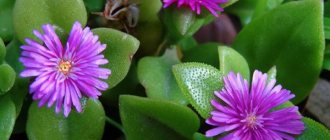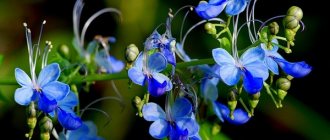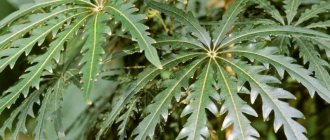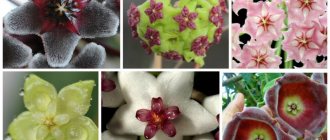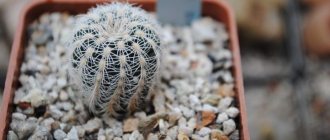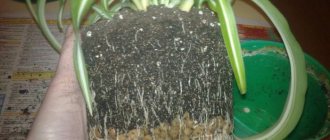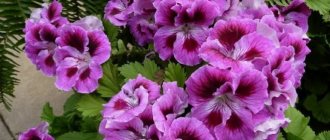Brief description of cultivation
- Illumination . Requires bright light, but should avoid direct sunlight.
- Temperature . During flowering, it is necessary to maintain the air temperature within 20-25°C. During the rest period – 13-15°C.
- Bloom . It begins to bloom in early June and ends in the first weeks of autumn.
- Watering . Abundant, after the top layer of soil dries.
- Air humidity . It must be high, this requires constant spraying. In winter, you need to remove the plant from heating appliances.
- Feeding . Conducted from mid-April to the end of the summer.
- Rest period . After flowering, that is, autumn-winter time.
- Trimming . When the flower begins to actively grow.
- Transplant . At the beginning of the growth period, a young bush is replanted once a year, an adult - once every three years.
- Reproduction . Seeds and cuttings.
- Pests . Spider mites, aphids, whiteflies, scale insects.
- Diseases . Chlorosis, rot.
Clerodendrum: how to make it bloom
There is one secret what to do to make indoor clerodendrum bloom. There is one sure way to provoke flowering - pruning.
The first buds to appear on the plant are the flower buds, and then the leaf buds. If the plant does not produce them on its own in early March, the plant should be pruned. Pruning must be done sparingly, the shorter the better. After the procedure, the plant should be transplanted into fertile soil. With this method of breaking dormancy, leaf buds first appear and its large green leaves begin to open, followed by active growth of flower buds.
Home care
Clerodendrum is a tropical flower, so you need to create conditions for it that will be as similar as possible to natural ones. In its natural environment, clerodendrum grows twining around tree trunks, so it needs constant support. The plant blooms better if it is frequently pruned and pinched .
Illumination
The flower needs a lot of light, but direct sunlight should not fall on it, otherwise the plant will die. The best option for placement in an apartment would be windows on the west and east sides. If you place clerodendrum on the south side, shading is necessary to protect the flower from active sunlight.
The plant will not bloom on a window located on the north side, as there will not be enough light.
Temperature
The favorable temperature for flowering clerodendrum is 20-25°C in summer. And in winter it is recommended to move the plant to a room where the air temperature is about 15°C.
Air humidity
The flower absorbs moisture over the entire surface of the leaves and must be regularly sprayed with a spray bottle. Also, clerodendrum does not tolerate dry air , which is why spraying is so important. Melt or rain water is suitable for this.
Melt water can be easily made at home. What does this require? A plastic bottle is filled with tap water and placed in the freezer. After the water has completely frozen, remove the container and defrost it at room temperature.
Watering
Watering the plant should be done regularly.
You cannot overwater the flower, otherwise the root system will rot. Therefore, watering should be moderate when the top layer of soil dries . In winter, watering is done even less frequently, but complete drying of the soil should also be avoided.
Fertilizer
Fertilize the flower no more than once a week in summer and once a month in winter. Liquid fertilizers suitable for indoor plants are excellent. When the flowering period has passed, feeding should be stopped and resumed closer to mid-spring.
Budding and blossoming
Flowering begins in early summer and ends in the first weeks of autumn . In winter, the plant is moved to a cool place. During this time, the flower may completely or partially shed its leaves and expose its shoots. This is a completely natural process that you do not need to be afraid of.
With the onset of spring, the stems of clerodendrum are cut off by one third so that the plant begins to bloom and branch even better.
Why doesn't it bloom buds?
This may be a consequence of improper care of the flower in winter. Clerodendrum is a plant that is very important for rest and needs time to recover in order to bloom with renewed vigor. You need to prepare the flower for the dormant period in the fall, when the shoots begin to grow more slowly. At this time, the amount of watering decreases and fertilizing stops.
Trimming
Pruning is an important procedure for a tropical plant. This is necessary for the flower to be lush, beautiful and retain its shape. If you do not trim the flower, the stems will branch heavily and will need support .
Also, there will be few new shoots and there will be no lush bush. Pruning is usually carried out in the spring, when the flower is actively growing, the shoots are shortened by one third, and dried and weak branches are removed. You can form a flower in the form of a standard tree; for this, one strong shoot is left, then the side branches are removed from it. When the plant reaches a height of 50 cm, pruning is done and new shoots are pinched, so the tree will have a lush crown.
Transfer
The young flower is replanted once a year, increasing the pot each time. An adult plant - every three years.
The roots of the flower are very fragile and are replanted using the transshipment method.
A deep pot is required for replanting. A drainage layer of approximately 4-5 cm is placed at its bottom. Suitable for drainage:
- Red brick;
- expanded clay;
- gravel.
The substrate itself consists of:
- Clay soil.
- Leafy soil.
- Fine river sand.
- Peat.
Before planting , the soil is disinfected to protect the flower from pests and fungi that may accidentally enter the soil.
Proper pruning of clerodendrum
Every gardener who has this plant in the house should know how to prune clerodendrum. There are 2 types of pruning:
The first is produced for the purpose of cutting off dry, diseased or damaged shoots, the second - to create a certain shape of the bush. To do this, you need to greatly shorten the shoots to stimulate their branching. A standard tree can be obtained by cutting off all shoots except the strongest (its height should be about 70 cm). The apical shoots should be pinched to form a crown.
A beautiful flower attracts attention not only with its appearance, but also with the pleasant aroma that comes from the flowers and leaves of the plant. Unpretentious care makes clerodendrum a welcome guest in every apartment.
Reproduction methods
There are two methods by which clerodendrum reproduces well: growing from seeds and cuttings.
Growing from seeds
To grow from seeds, you can use store-bought seeds or collect them from an existing flower. Sowing is carried out at the end of February or beginning of March. The planting algorithm is as follows:
- The pot is filled with a mixture consisting of peat, sand and turf soil.
- Next, the seeds are evenly distributed on its surface.
- Then a small greenhouse is made and the container with the seeds is placed in a warm place with good lighting.
- It is necessary to regularly ventilate and moisten the soil.
With proper care, the first shoots will appear after 6-8 weeks. After 3-4 full leaves are formed, the seeds are planted in small containers or cups with drainage holes.
Propagation by cuttings
Cuttings begin in the spring; they are harvested when pruning the plant. Shoot cuttings are used as cuttings. The shoots are placed in a container with water and covered with polyethylene. After a while, roots will form on the cuttings, after which they are planted in the ground. But it is worth remembering that the roots are very fragile and weak, so you need to plant them very carefully so as not to damage them.
- First, arrange a drainage layer of 3-4 cm.
- Next, 1/3 of the pot is covered with the prepared substrate.
- The soil needs to be watered abundantly.
- Then the cuttings are carefully planted and soil is added in the required amount.
- The container with the cutting is covered with a glass jar or plastic bottle.
- The planted cuttings must be regularly watered and ventilated.
- The shelter is completely removed when the first leaves appear.
When the cuttings are completely rooted, they can be planted in the pots in which they will grow in the future.
The video shows propagation by cuttings:
Transfer
It needs replanting annually, since the root system is very developed and grows quickly. More often than not, it looks more like a transshipment than a transfer. The roots of the plant are very delicate, it is better not to touch them.
Note! You cannot remove the roots too much from the soil, as you can damage them, which can also cause a lack of flowering.
The flower is picky about soil: it needs nutritious, slightly acidic soil. To create these conditions, you need to mix in equal parts:
- clay soil;
- leaf soil;
- peat;
- coarse sand.
Note! Before transplanting, the soil is disinfected with steam or in the oven.
Pests and diseases
If not properly cared for, the flower weakens and becomes susceptible to pests.
Pests
Spider mite
The pest can be detected by the presence of cobwebs on the stems and limp foliage . To combat ticks, use a soap solution. If the damage is severe, then chemical agents are used. For prevention, the air and flower should be regularly moistened.
Aphid
When affected by aphids, the plant stops growing, leaves and flowers become deformed and fall off. Infected areas need to be cut off and the flower treated with soapy water or an antifungal agent.
Whitefly
Whitefly larvae can usually be found on the undersides of leaves. The leaves will become deformed and fall off.
To combat whitefly, you need to remove the affected leaves and treat the flower with an insecticide.
Shchitovka
Signs of scale insects are small yellow dots on the leaves, which enlarge over time, and the leaves begin to fall off and dry out. If the parasite is not detected in time, the clerodendrum may die.
If there are few scale insects, they can be removed with a brush and treated with a soap solution. If the lesion is large, then chemical treatment will be required.
Why doesn't it bloom?
Clerodendrum does not bloom in the following cases:
- The rest period was organized incorrectly.
- The flower has been growing in the same pot for a very long time.
- Deficiency or excess of nutrients.
To eliminate the problem, you need to adjust the application of fertilizers, transplant the flower into a new container and ensure proper dormancy in the winter.
In winter, the flower should be located in a cool place. After flowering ends, watering is reduced and the flower pot is placed in a room where the temperature is maintained at +15. During the dormant period, the plant gains strength for future flowering, usually this period lasts 1.5-2 months until new shoots appear.
The leaves are turning yellow
If a flower begins to turn yellow in summer or spring, this indicates a lack of moisture in the soil . In this case, the plant must be watered more often and more so that there is always water in the pan. Chlorosis can also be the cause of yellow leaves; this can be eliminated by fertilizing with preparations containing iron.
The leaves are falling
If the leaves fall after flowering, then this process is natural. But if the leaves fly around in summer or spring, then it is worth reviewing the rules for caring for the flower. Maybe it is not watered correctly or the flower is in the wrong place.
Why does clerodendrum not bloom?
Many flower growers believe that this flower has good energy and brings feminine happiness to the home. The green beauty is a lover of the warmth of the African and American tropics. There its vines reach up to 4 m in length, green leaves cover the entire length of the shoots every year, falling off during cold weather. The shoots become woody, which allows this plant to be grown as a tree or bush.
Flowering of a contrasting beauty
Flowering occurs from the beginning of spring until the first days of autumn. At home, you can most often find Mrs. Thompson's clerodendrum and Clerodendrum Prospero. For the Thomson and Clerodendrum Prospero species, home care is the same, they differ only in shape and color palette.
Article on the topic: Oregano plant - planting and care in the garden, description of varieties
If left long, the plant may pull its shoots upward, requiring garter, or fall down from the hanging pot
The conditions for keeping the evergreen representative of the Verbenov family are simple. The lack of flowering is associated precisely with insufficient care. Main reasons:
- improper care during plant hibernation;
- improper exit from a state of rest;
- lack of fertilizing or untimely replacement of soil;
- incorrect pruning.
How Thomson's clerodendrum with red stamens and snow-white Prospero bloom
Views from photos
Thomson (Thomsoniae)
A distinctive feature is flowering; red flowers with hanging stamens bloom against a background of white bracts. It blooms from early April to June, but with careful care it can begin to bloom in the fall.
Shiny (Splendens)
A green bush with climbing stems, leaves growing in whorls of 3 pieces. The inflorescences are scarlet in color and form dense racemes . With proper care they can bloom throughout the year.
Philippine (Philippinum)
It can reach a height of 2 m. The flowers are collected in a basket and resemble small roses, the edges of the petals are openwork. They have a pleasant, sweetish smell.
Ugandan (Ugandense)
It is a liana-like subshrub. The upper and lateral petals are blue, and the lower petals are purple. A feature of this species is the duration of flowering: faded inflorescences are quickly replaced by new ones. Grows well in open ground and can grow up to 3 in a few months.
Fragrant (Fragrans)
An evergreen shrub up to 2 m high. The flowers have a light pink hue and a special aroma , reminiscent of a mixture of citrus and violets. With good care it can bloom all year round.
Wallich or Prospero
Smooth-leaved evergreen shrub with white inflorescences and long stamens. It is also called the “bridal veil”. The branches of the bush are red-green with dark green oblong leaves. This species requires careful care, it needs a lot of light and high humidity.
Beautiful (Speciosum)
An evergreen shrub up to 3 m high. The inflorescences consist of small purple flowers. Heart-shaped leaves. Flowering period from early June to late September.
Clerodendrum - a flower for a good mood
It is interesting that clerodendrum began to be grown as an indoor flower relatively recently, acquiring the well-deserved love of flower growers. Interior designers also did not ignore this touching and delicate plant. It looks great in winter gardens and interiors with a touch of romance.
They say that contemplating its flowers not only brings aesthetic pleasure, but also gives thoughts a positive attitude, relieves stress and excessive irritability. I confirm!
The plant has several popular names, for example, “innocent love” or “volkameria”. At first it seemed strange to me that the main nickname was the “tree of fate,” although in structure my clerodendrum is a pronounced liana. It needs support and space, then flexible branches with dark green embossed leaves can stretch up to 3 meters.
I have Thompson's clerodendrum (Clerodendrum thomsoniae) growing, and my friends' Philippine one has taken root quite well. Having become interested, I learned that there are also tall species that fully justify the word “tree” in the name:
All types of clerodendrum have a subtle, pleasant aroma with a unique shade, which is attributed to antidepressant properties.
The history of the plant goes back to Ancient Rome, where clerodendrum was dedicated to Venus, revered and tried to be grown in large quantities. Officially, the tropics of Africa, Asia and South America are called its homeland. It is not possible to determine the origin more precisely.
Clerodendrum has several popular names, for example, “innocent love” or “volkameria”. © onlineplantguide
Clerodendrum: proper pruning
Pruning is an important procedure for this flowering plant friend. It is on young shoots that good flowers form. To provoke the growth of young shoots, you need to cut off the old ones. The shoots should be shortened by at least 1/3 of the length.
Using pruning, you can form a tree, bush or long vines that will entwine the support
Even though clerodendrum requires attention at the beginning of spring, it rewards this care with beautiful flowering. Its flowers look bright and festive and exude a honey aroma. This is a worthy decoration for any home.
Sources:
https://www.botanichka.ru/article/pochemu-ne-tsvetet-klerodendrum/ https://greensotka.ru/tsvetushchie/pochemu-ne-tsvetet-klerodendrum.html https://pocvetam.ru/komnatnye-rasteniya /pocemu-ne-cvetet-klerodendrum.html

